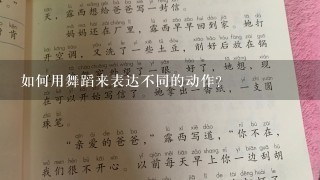如何用舞蹈来表达不同的动作?

Answer:
How to Use Dance to Express Different Actions
1. Body Movements:
- Slow and graceful: Slow and deliberate movements convey a sense of calmness, serenity, or contemplation.
- Fast and energetic: Fast and powerful movements express excitement, energy, or urgency.
- Cursive and flowing: Cursive and flowing movements suggest grace, elegance, or gracefulness.
- Swaying and shaking: Swaying and shaking movements convey a sense of rhythm, energy, or excitement.
2. Gestures and Expressions:
- Pointing: Pointing with your fingers or a pointer can represent a specific object, person, or action.
- Slapping: Slapping your hands together can express anger, excitement, or a sudden burst of energy.
- Shaking: Shaking your head or body can convey a sense of disbelief, confusion, or disapproval.
- Pointing up or down: Pointing up or down can represent a specific direction, level, or position.
3. Choreography and Movement Patterns:
- Storytelling: Choreographed dances can tell a story, express a feeling, or depict a historical event.
- Social dancing: Group dances allow people to connect, express themselves, and celebrate together.
- Ballet and modern dance: These styles emphasize grace, precision, and storytelling.
4. Props and Objects:
- Using props: Props like scarves, sticks, or props can enhance the meaning and expression of a dance.
- Objects in motion: Objects that move in a specific way can represent a particular action or object.
5. Context and Environment:
- Formal setting: Formal dances are typically performed in a structured environment with specific rules and etiquette.
- Informal setting: Informal dances can be more relaxed and spontaneous, often in public spaces.
6. Personal Expression:
- Find your rhythm: Experiment with different movements and find what resonates with you.
- Express yourself: Use dance as a way to communicate your emotions, thoughts, and experiences.
-
Be creative: Explore different styles and techniques to find your unique expression.





































































